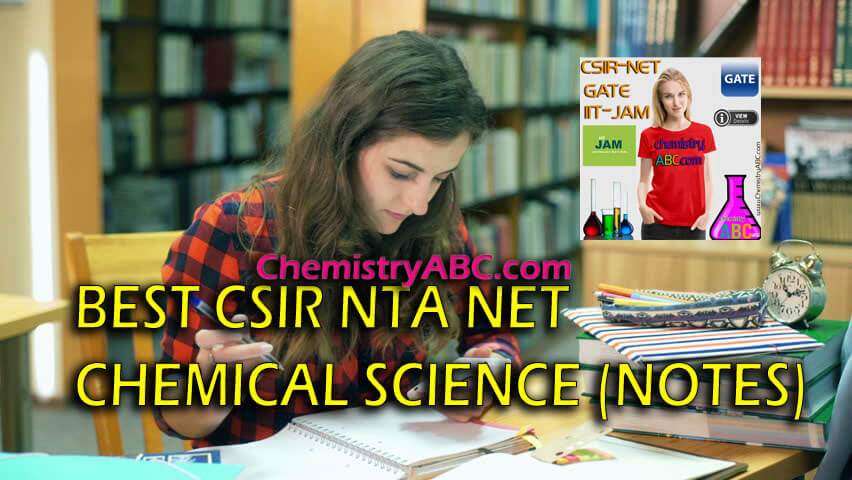CSIR NET Chemical Science detailed unit-wise syllabus has been provided here, along with exam pattern and preparation tips. Candidates opting for CSIR NET Chemical Science can go through the syllabus provided here, which will help in preparation.
.
| Name of the Section | Total no. of Questions | Maximum Marks | Marks per Question | Time Duration |
|---|---|---|---|---|
| Part ‘A’ (General Science, Quantitative Reasoning & Analysis, and Research Aptitude) | 20 (Candidate is required to answer any 15 questions) | 30 | 2 | 2 hours |
| Part ‘B’ (Topics mentioned in Syllabus) | 40 (Candidate is required to answer any 35 questions) | 70 | 2 | |
| Part ‘C’ (Knowledge of scientific concepts and their applications) | 60 (Candidate is required to answer any 25 questions) | 100 | 4 |
Note: The exam includes a negative marking. Incorrect answers result in a 0.25-mark deduction. Here you may view the CSIR UGC NET Exam Pattern 2024.
Also Read: CSIR NET PDF Notes.
CSIR NET Section-wise Chemical Science Syllabus 2024
Chemical Science Syllabus 2024 is divided into 3 parts: Part A covers all posts, and Parts B and C cover the subject-specific topics. Important topics are enantioselectivity, organic chemistry fundamentals and chiral auxiliaries, nuclear reactions-fission and fusion-enzyme kinetics, etc.
CSIR NET Chemistry Syllabus (Part A)
The CSIR NET Chemical Science Syllabus for Part A is available to candidates in the table below.
| Reasoning | Graphical Analysis & Data Interpretation | Numerical Ability |
|---|---|---|
| Puzzle | Pie-Chart | Geometry |
| Series Formation | Line & Bar Chart | Proportion and Variation |
| Clock and Calendar | Graph | Time and Work |
| Direction and Distance | Mode, Median, Mean | HCF and LCM |
| Coding and Decoding | Measures of Dispersion | Permutation and Combination |
| Ranking and Arrangement | Table | Compound and Simple Interest |
CSIR NET Chemistry Syllabus 2024 (Part B and C)
Below is the table that includes the CSIR NET Chemical Science Syllabus for Part B and C.
| Interdisciplinary Topics | |
|---|---|
| CSIR NET Chemical Science Interdisciplinary Topics | Medicinal chemistry |
| Supramolecular Chemistry | |
| Environmental chemistry | |
| Chemistry in nanoscience and technology | |
| Catalysis and green chemistry | |
| Organic Chemistry | |
| Common named reactions and rearrangements | Applications of organic synthesis. |
| Principles of stereochemistry | Configurational and conformational isomerism |
| Asymmetric induction | |
| Diastereoselectivity | |
| Stereogenicity | |
| Stereoselectivity | |
| Enantioselectivity | |
| Geography of India | |
| Concepts in organic synthesis | Disconnection |
| synthons | |
| protecting groups | |
| linear and convergent synthesis | |
| Asymmetric synthesis | Resolution – optical and kinetic. |
| Determination of enantiomeric and diastereomeric excess | |
| Chiral auxiliaries | |
| Asymmetric induction methods– substrate, reagent, and catalyst-controlled reactions | |
| Determination of organic compounds | IR & UV |
| Mass spectroscopic methods | |
| Pericyclic reactions | Cycloaddition |
| Sigmatropic rearrangements, electrocyclization | |
| Other related concerted reactions. | |
| Organic chemistry’s principles and applications of photochemical reactions | |
| Physical Chemistry | |
| Chemical Application | Symmetry elements |
| Character tables | |
| Group theory | |
| Polymer Chemistry | Kinetics of polymerization |
| Molar masses | |
| Atomic Structure | Spectroscopy |
| Antisymmetry principle | |
| Many-electron systems | |
| Solid-state | Bragg’s law and applications |
| Band structure of solids | |
| Crystal structures | |
| Colloids and surfaces | Isotherms and surface area |
| heterogeneous catalysis | |
| Properties of colloid | |
| Data analysis | Absolute and relative errors |
| Covariance and correlation coefficient | |
| Mean and standard deviation | |
| Chemical kinetics | Complex reactions |
| Determination of reaction mechanisms | |
| Steady-state approximation | |
| Empirical rate laws and temperature dependence | |
| Enzyme kinetics | |
| Approximate methods of quantum mechanics | Perturbation theory up to second order in energy |
| Variational principle; and its applications | |
| Molecular spectroscopy | Basic principles of magnetic resonance |
| Electronic spectra | |
| Rotational and vibrational spectra of diatomic molecules | |
| Elementary concepts of MO and VB theories | Huckel theory |
| Chemical bonding in diatomics | |
| Electrochemistry | Includes topics such as Ionic equilibria |
| Conductometric and potentiometric titrations | |
| DebyeHuckel theory | |
| Inorganic Chemistry | |
| Organometallic compounds | Bonding and structure |
| Bonding and structure | |
| Reactivity, and synthesis. | |
| Organometallics in Homogeneous Catalysis | |
| Nuclear chemistry | Radio-analytical techniques |
| Activation analysis | |
| Nuclear reactions, fission, and fusion | |
| Bioinorganic chemistry | Porphyrins |
| Photosystems | |
| Oxygen transport | |
| Nitrogen fixation. | |
| Metal complexes in medicine | |
| Concepts of acids and bases | Non-aqueous solvents |
| hard-soft acid-base concept | |
| Chemical periodicity | Periodic table |
| Elements | |
| Groups | |
| Inner transition elements | Redox chemistry |
| Spectral and magnetic properties | |
| Analytical applications | |




